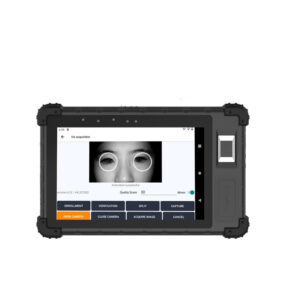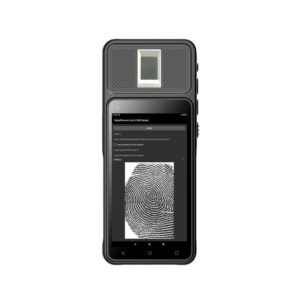What is a Biometric Mobile Device?
How Does a Biometric Mobile Device Work?
1. Data Capture: Scanning Unique Biometric Traits
The first step in any biometric mobile device is capturing the user’s unique biological features. This is achieved through advanced sensors designed for high precision. Depending on the device, these sensors may include:
Fingerprint Scanning: Optical or capacitive sensors detect intricate ridge patterns, valleys, and minutiae points on a finger. Many modern devices also include liveness detection, which prevents spoofing using fake fingerprints.
Facial Recognition: High-resolution cameras capture facial landmarks, including eye distance, nose shape, and jawline contours. Infrared or 3D depth sensors enhance accuracy and provide anti-spoofing protection.
Additional Biometrics: Some devices support iris scanning, palm vein recognition, or voice recognition, offering multi-factor authentication for sensitive applications.
This stage ensures precise data capture, even under varying lighting conditions, angles, or minor physical changes, providing a solid foundation for secure authentication.
2. Data Processing: Converting Biometric Data into Secure Templates
After capturing the biometric input, the biometric mobile device processes the raw data into a digital template. This involves several critical steps:
Feature Extraction: The system identifies unique patterns, key points, or vascular structures within the input. For example, fingerprints are analyzed for ridge endings and bifurcations, while facial recognition measures spatial relationships among facial features.
Template Generation: The extracted features are converted into a compact, encrypted digital template. Importantly, the template does not store the raw image, making it secure and non-reversible.
Secure Storage & Encryption: Templates are securely stored on the device or a connected server. Advanced encryption ensures the data cannot be misused even if intercepted, and some devices utilize hardware-based secure enclaves for maximum protection.
This processing stage guarantees that the biometric data is optimized for fast and reliable comparison while maintaining high-level security.
3. Verification & Authentication: Matching Biometric Data in Real-Time
The final stage is the verification and authentication process, where the biometric mobile device compares live input against stored templates to confirm identity:
Matching Algorithms: Sophisticated algorithms measure similarity between the new input and stored templates, accounting for minor variations like facial expressions, lighting, or finger positioning.
Threshold & Access Decision: Access is granted only if the similarity score exceeds a defined threshold, balancing convenience and security.
Anti-Spoofing Measures: Many devices incorporate liveness checks, such as blink detection, pulse detection, or vein pattern analysis, to prevent fraudulent attempts.
This stage ensures fast, accurate, and secure access, making biometric mobile devices ideal for mobile banking, secure facility access, identity verification, and other high-security applications.
Key Features of Biometric Mobile Devices
Biometric mobile devices are increasingly used across a wide range of industries and scenarios:
Law Enforcement & Public Safety – Quickly identify individuals in the field using portable biometric scanners.
Enterprise & Workforce Management – Track employee attendance or restrict access to secure areas.
Các dịch vụ tài chính – Enable secure mobile banking authentication.
Healthcare – Verify patient identity and control access to sensitive medical records.
Government & Border Control – Efficiently authenticate travelers and manage immigration processes.
These applications highlight how biometric mobile devices improve security, streamline operations, and enhance convenience in real-world scenarios.
Applications of Biometric Mobile Devices
Biometric mobile devices are increasingly used across a wide range of industries and scenarios:
Law Enforcement & Public Safety – Quickly identify individuals in the field using portable biometric scanners.
Enterprise & Workforce Management – Track employee attendance or restrict access to secure areas.
Các dịch vụ tài chính – Enable secure mobile banking authentication.
Healthcare – Verify patient identity and control access to sensitive medical records.
Government & Border Control – Efficiently authenticate travelers and manage immigration processes.
These applications highlight how biometric mobile devices improve security, streamline operations, and enhance convenience in real-world scenarios.
Benefits of Using a Biometric Mobile Device
Enhanced Securit
Biometric authentication offers a level of security that is difficult to replicate because each person’s biometric data—such as fingerprints, facial features, or iris patterns—is unique. Unlike traditional passwords or access cards, which can be stolen, shared, or duplicated, biometric identifiers are tied to the individual and nearly impossible to forge. A biometric mobile device ensures that only the authorized user gains access, significantly reducing the risks of fraud, identity theft, and unauthorized entry.
Sự tiện lợi
One of the greatest advantages of a biometric mobile device is the convenience it brings to users. There is no need to remember complex passwords, carry physical keys, or manage access cards. Authentication becomes seamless and instant—simply present a fingerprint, face, or palm to gain access. This eliminates user frustration, minimizes lockouts, and improves overall user experience, making biometric authentication a preferred choice for businesses and individuals alike.
Sự chính xác
Modern biometric authentication systems are built on advanced algorithms that deliver high precision in verifying user identity. Whether it is distinguishing between similar facial features or detecting minute details in a fingerprint, the system ensures extremely low rates of false positives and false negatives. This accuracy allows biometric mobile devices to operate reliably in critical industries such as banking, healthcare, and government services where even the smallest error can have major consequences.
Hiệu quả
Speed is another key advantage of biometric mobile devices. In high-traffic environments—such as office buildings, transportation hubs, or event venues—biometric authentication can process large volumes of users in seconds. Unlike manual ID checks or password input, biometric verification is almost instantaneous, reducing waiting times, preventing bottlenecks, and improving workflow efficiency. This makes biometric technology ideal for organizations that prioritize both security and operational productivity.
Tính linh hoạt
A biometric mobile device is designed to be highly adaptable, functioning effectively in a wide range of environments. Whether used indoors for corporate offices, outdoors for construction sites, or on-the-go for mobile workforce management, biometric authentication remains consistent and secure. Devices can integrate with access control systems, time attendance solutions, and visitor management platforms, offering businesses a versatile and scalable security solution that fits multiple industries and use cases.
Phần kết luận
Understanding what a biometric mobile device is is crucial for businesses, governments, and organizations looking to enhance security and operational efficiency. By leveraging unique biological traits, biometric mobile devices provide secure, fast, and reliable authentication, making them an essential part of modern access control, workforce management, and identity verification systems.
Liên hệ chúng tôi
We would love to speak with you.
Feel free to reach out using the below details.



